Abstract
A variety of biological active compounds can be classified as 2-substituted 1,4-benzodioxanes bearing one or more substituents at the benzene. The synthesis of these important templates can be approached by different strategies. The most straightforward ones generally lead to mixtures of positional isomers, whose identification can be more problematic than separation. Here, we unambiguously elucidate, by HSQC and HMBC NMR analyses, the structure of methyl 8- and 5-bromo-1,4-benzodioxane-2-carboxylate, two versatile synthetic intermediates that are one-step-obtainable from commercial products and easily separable. As conceived, the identification procedure is, in principle, generalizable to any pair of 2-substituted 1,4-benzodioxanes bearing an X substituent at C(8) or C(5).
1. Introduction
1,4-benzodioxane occurs as a key substructure in a variety of compounds, many of which exert biological activity and have therapeutic potential. Its applications in drug design, which range from antibacterial agents to cancer chemotherapics, adrenergic, serotoninergic and nicotinic receptor antagonists and agonists, and a variety of enzyme inhibitors, have been recently reviewed [1]. Mostly, the interaction capabilities of these molecules with biological targets are critically related to two structural features, namely the substitution at the benzodioxane C(2) and the decoration of the benzene ring with different substitution patterns (Figure 1), the former resulting in chirality and often in high eudismic ratios [2] and the latter mainly translating into different selectivity profiles for receptor subtypes of the same family [2,3,4].
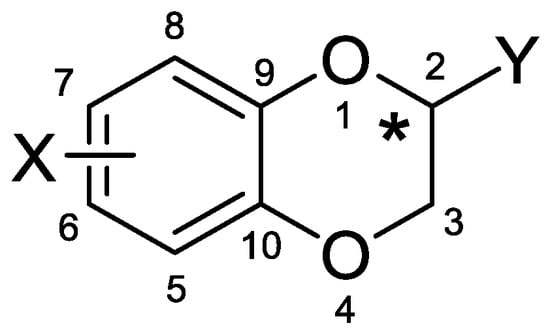
Figure 1.
General formula of a chiral 2-substituted 1,4-benzodioxane bearing a substituent at the benzene ring.
Many methods, based on different approaches, have been developed to prepare both racemic and unichiral 2-substituted 1,4-benzodioxanes [5], while the decoration of the benzene ring of the latter relies on two alternative strategies: the construction of the bicycle by condensation of a C3 synthetic unit with benzene already bearing the desired substituents (strategies A and A’, Scheme 1) or the benzene decoration of the preformed 2-substituted 1,4-benzodioxane (strategy B, Scheme 1) [6].
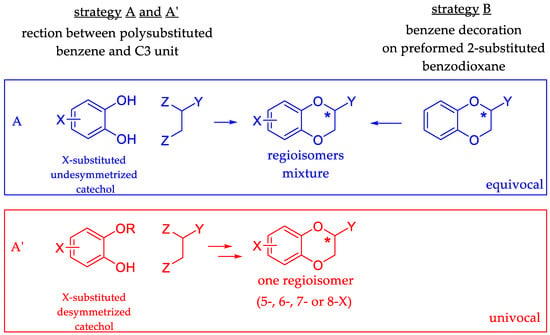
Scheme 1.
Synthetic strategies to construct 2-substituted 1,4-benzodioxanes decorated at the benzene ring. Z: leaving EWG group in the nucleophilic attack by catechol; Y: any substituent, better if it makes carbon more electrophilic; R: removable O-protecting group.
Common issues of the two strategies are the production of positional isomers [6]. When applying the former approach, this problem can be bypassed by using differentially substituted desymmetrized catechols (strategy A’), such as ortho, meta and para substituted catechol monoethers, whose preparation and analytical characterization, however, is often laborious. A striking example is provided by the regioisomers of nitrocatechol monobenzyl ether [7], mono O-MEM-protected 4-bromocatechol [8] and 4-chlorocatechol monobenzyl ether [9], used to prepare 2-substituted 1,4-benzodioxane bearing -NO2, -NH2, -Br and -Cl substituents at the aromatic ring as nicotinic ligands [3,8] and antibacterial agents [9]. Otherwise, when using substituted undesymmetrized catechols (strategy A) or functionalizing preformed 2-substituted 1,4-benzodioxane at the benzene ring (strategy B), two or more positional isomers must be foreseen as products, whose unequivocal identification can be more difficult than their separation. Nevertheless, such synthetic approaches (strategies A and B) are attractive for a greater straightforwardness than strategy A’.
As we are interested in the preparation of 1,4-benzodioxane-based nicotinic ligands, here we report the unambiguous establishment of the 8- or 5-bromo substitution of methyl 1,4-benzodioxane-2-carboxylate, 1 and 2, respectively, prepared according to approach A by HMBC NMR analyses (Figure 2). Among the polysubstituted benzodioxanes, we considered these two derivatives because of their versatility as synthetic intermediates, due to the exploitable reactivity of the ester function [6,10,11,12] and bromine [13,14], and their trivial accessibility by the reaction between commercially available methyl 2,3-dibromopropionate and 3-bromocatechol.
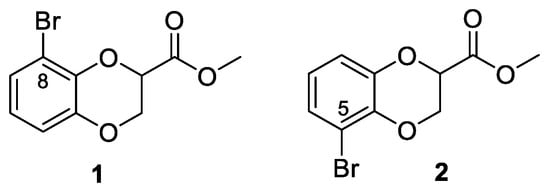
Figure 2.
Methyl 8-bromo-1,4-benzodioxane-2-carboxylate (1) and methyl 5-bromo-1,4-benzodioxane-2-carboxylate (2).
2. Results and Discussion
Methyl 5-bromo- and 8-bromo-1,4-benzodioxane-2-carboxylate were easily prepared by a combination of equimolar amounts of commercially available methyl 2,3-dibromopropionate and 3-bromocatechol in acetone in the presence of three equivalents of potassium carbonate at reflux temperature overnight. After a standard work-up, the crude product was purified by chromatography on silica gel eluting with 80/20 petroleum ether/ethyl acetate isolating two fractions. The first eluted product, 1, subsequently identified as methyl 8-bromo-1,4-benzodioxane-2-carboxylate by HMBC NMR analysis, was obtained with a 25% yield, while the second eluted product, 2, subsequently identified as methyl 5-bromo-1,4-benzodioxane-2-carboxylate by HMBC NMR analysis, was obtained with a 40% yield.
As shown in Figure 3, 1H NMR and 13C NMR spectra of both 1 and 2 were consistent with the structure of methyl 1,4-benzodioxane-2-carboxylate brominated at C(5) or C(8), as expected on the basis of the used synthons. In the aliphatic region, two double doublets were imputable to the dioxane CH2 and the triplet at the lower field to the dioxane CH, while, in the aromatic region, the triplet and the two double doublets, from the high field to low field, identified, respectively, the hydrogen meta to bromine and the two hydrogens ortho and para to bromine. However, the assignment of the 1 and 2 structures to the first and the second eluted products, respectively, or vice versa, was highly questionable because identical patterns of signals and multiplicity with non-decisive chemical shift differences were observed in the 1H NMR spectra, while the 13C NMR spectra were indistinguishable.
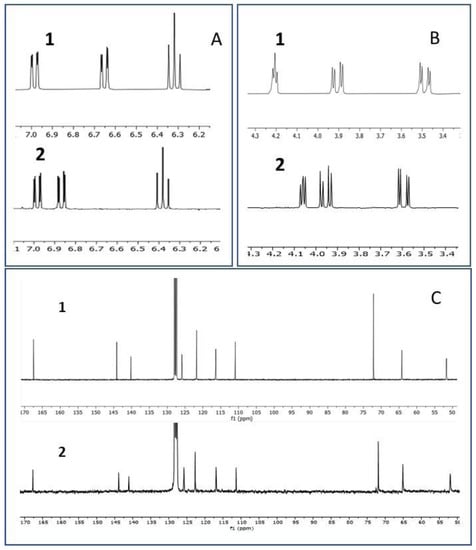
Figure 3.
(A) Aromatic region and (B) aliphatic region of the 1H NMR spectra of 1 and 2 and (C) 13C NMR spectra of 1 and 2. (A) The three adjacent hydrogens of the benzene ring give an analogous sequence of signals: dd, dd and t (from low field to high field). (B) The three hydrogens of the dioxane portion give an analogous sequence of three dd. (C) The spectra are indistinguishable. All the spectra were registered in C6D6.
Additionally, HSQC NMR spectra were not conclusive. They allowed the certain assignment of four of the benzene carbons: (a) the signal at 111 ppm to the brominated carbon, (b) the signal at 122 ppm to the CH meta positioned to C-Br, (c) the signal at 126 ppm to the CH ortho positioned to C-Br, and, consequently, (d) the signal at 117 ppm to that para positioned to C-Br (Figure 3C). The distinctive assignments of the peaks at 140 and 144 ppm to the two quaternary carbons shared between the two cycles, namely (C(9) and C(10), remained instead unresolved (Figure 3C). Therefore, we reasoned that HMBC NMR analysis could be resolutive for the identification of the signals imputable to C(9) and C(10) and, consequently, for the unequivocal identification of the two regioisomers. In 1, an important correlation with one or both methylene hydrogens of dioxane should identify C(10), with which the aromatic H giving a triplet should also be correlated (Figure 4). Otherwise, in 2, we should observe an important correlation with one or both methylene hydrogens of dioxane by C(10) again, but no correlation or a weak one with the aromatic H giving the triplet (Figure 4). The latter, in 2, should instead couple with C(9), in turn recognizable for no coupling with methylene hydrogens of dioxane. The two different patterns of three-bond C-H correlations, expected to distinguish 1 from 2, are depicted in Figure 4.
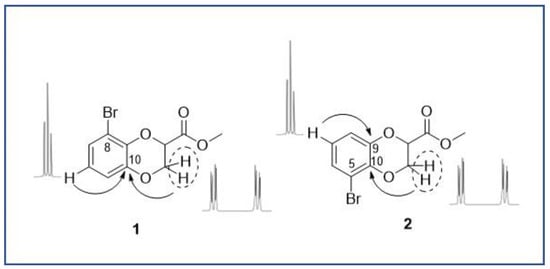
Figure 4.
Expected important three-bond couplings of the dioxane geminal hydrogens with C(10) in both 1 and 2 and of the aromatic hydrogen giving a triplet with C(10) or C(9) in 1 and 2.
Such expectations were confirmed by NMR experiments. In the HMBC spectrum of 1 (optimized for 8 Hz), both the aromatic proton meta positioned to bromine, unequivocally identified by triplet multiplicity, and the methylene protons of the dioxane ring, unequivocally identified by two double doublets, showed a strong 3JH/C correlation to carbon C(10) (Figure 5). In the HMBC spectrum of 2 (optimized for 8 Hz), one of the methylene protons of the dioxane ring showed a strong 3JH/C correlation to carbon C(10), as observed for 1, but the aromatic proton meta positioned to bromine was correlated to carbon C(9) (Figure 6). These results unequivocally indicated that 1, the first eluted product, was the isomer bearing bromine in the 8 position and that 2, the second eluted product, was the 5-brominated isomer.
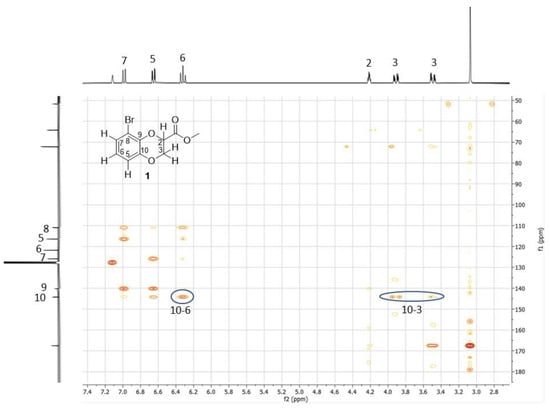
Figure 5.
HMBC spectrum of 1 in C6D6 displaying important correlations between C(10) and H(6) and between C(10) and H(3).
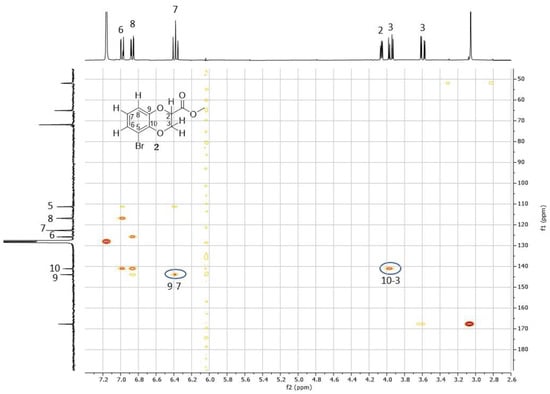
Figure 6.
HMBC spectrum of 2 in C6D6 displaying important correlations between C(9) and H(7) and between C(10) and H(3).
As a consequence of the identification by HMBC NMR, the difference in chemical shift of the proton para to bromine in the 1H NMR spectra (see Figure 3A) became diagnostic of the bromine position on the 1,4-benzodioxane nucleus: high-field H-5 in 8-brominated 1, low-field H-8 in 5-brominated 2.
3. Materials and Methods
The 1H and 13C NMR and two-dimensional (2D) (HSQC, and HMBC) spectra, which are all reported as Supplementary Materials, were measured on a Varian Mercury 300 FT-NMR spectrometer operating at 300 MHz for 1H and 75 MHz for 13C. NMR data were recorded at 25 °C, with chemical shifts δ reported in parts per million and coupling constants J in Hertz. 1H NMR spectra were recorded in C6D6, while 13C NMR, HSQC and HMBC spectra were recorded in C6D6. Spectra can also be recorded in DMSO-d6.
4. Conclusions
In summary, we have unambiguously identified methyl 8-bromo- and 5-bromo-1,4-benzodioxane-2-carboxylate (1 and 2, respectively), two versatile synthons easily obtainable as a chromatographically resolvable mixture from 3-bromocatechol and methyl 2,3-dibromopropionate, by HMBC NMR. Structure elucidation was achieved by the unambiguous assignment of the two quaternary carbons shared between the two cycles in the HMBC spectrum of the two compounds and by a different pattern of 3JH/C correlation with these two carbons by the methylene hydrogens and the hydrogen meta to bromine. Since these latter hydrogens are unequivocally assignable in the 1H NMR spectra, many other pairs of 2-substituted 1,4-benzodioxane bearing an X substituent at the 8 or 5 position may be unambiguously identified by the same comparison of 3JH/C data that we have here applied to the regioisomers 1 and 2.
Supplementary Materials
The following supporting information can be downloaded online, Preparation of 1 and 2; 1H NMR spectra of 1 and 2 in C6D6; 13C NMR spectra of 1 and 2 in C6D6; HSQC spectra of 1 and 2 in C6D6; HMBC spectra of 1 and 2 in C6D6.
Author Contributions
Conceptualization, C.B.; methodology, E.A.; investigation, E.A. and A.G.; writing—review and editing, M.P.; supervision, C.B. All authors have read and agreed to the published version of the manuscript.
Funding
This research received no external funding.
Data Availability Statement
The data for the compound presented in this study are available in the Supplementary Materials of this article.
Acknowledgments
The authors acknowledge support from University of Milan through the APC initiative.
Conflicts of Interest
The authors declare no conflict of interest.
Sample Availability
Samples of the compounds are not available from the authors.
References
- Bolchi, C.; Bavo, F.; Appiani, R.; Roda, G.; Pallavicini, M. 1,4-Benzodioxane, an evergreen, versatile scaffold in medicinal chemistry: A review of its recent applications in drug design. Eur. J. Med. Chem. 2020, 200, 112419. [Google Scholar] [CrossRef] [PubMed]
- Fumagalli, L.; Pallavicini, M.; Budriesi, R.; Gobbi, M.; Straniero, V.; Zagami, M.; Chiodini, G.; Bolchi, C.; Chiarini, A.; Micucci, M.; et al. Affinity and activity profiling of unichiral 8-substituited 1,4-benzodioxane analogues of WB4101 reveals a potent and selective α1B-adrenoceptor antagonist. Eur. J. Med. Chem. 2012, 58, 184–191. [Google Scholar] [CrossRef] [PubMed]
- Bavo, F.; Pallavicini, M.; Gotti, C.; Appiani, R.; Moretti, M.; Colombo, S.F.; Pucci, S.; Viani, P.; Budriesi, R.; Renzi, M.; et al. Modifications at C(5) of 2-(2-pyrrolidinyl)-substituted 1,4-benzodioxane elicit potent α4β2 nicotinic acetylcholine receptor partial agonism with high selectivity over the α3β4 subtype. J. Med. Chem. 2020, 63, 15668–15692. [Google Scholar] [CrossRef] [PubMed]
- Bavo, F.; Pallavicini, M.; Appiani, R.; Bolchi, C. Determinants for α4β2 vs. α3β4 subtype selectivity of pyrrolidine-based nAChRs ligands: A computational perspective with focus on recent cryo-em receptor structures. Molecules 2021, 26, 3603. [Google Scholar] [CrossRef]
- Bolchi, C.; Valoti, E.; Straniero, V.; Ruggeri, P.; Pallavicini, M. From 2-aminomethyl-1,4-benzodioxane enantiomers to unichiral 2-cyano- and 2-carbonyl-substituted benzodioxanes via dichloroamine. J. Org. Chem. 2014, 79, 6732–6737. [Google Scholar] [CrossRef]
- Bouissane, L.; Khouili, M.; Coudert, G.; Pujol, M.D.; Guillaumet, G. New and promising type of leukotriene B4 (LTB4) antagonists based on the 1,4-benzodioxine structure. Eur. J. Med. Chem. 2023, 254, 115332. [Google Scholar] [CrossRef] [PubMed]
- Bolchi, C.; Bavo, F.; Pallavicini, M. Preparation and unequivocal identification of the regioisomers of nitrocatechol monobenzyl ether. Synth. Commun. 2017, 47, 1507–1513. [Google Scholar] [CrossRef]
- Bolchi, C.; Gotti, C.; Binda, M.; Fumagalli, L.; Pucci, L.; Pistillo, F.; Vistoli, G.; Valoti, E.; Pallavicini, M. Unichiral 2-(2′-pyrrolidinyl)-1,4-benzodioxanes: The 2R,2’S diastereomer of the N-methyl-7-hydroxy analogue is a potent α4β2 and α6β2-nicotinic acetylcholine receptor partial agonist. J. Med. Chem. 2011, 54, 7588–7601. [Google Scholar] [CrossRef] [PubMed]
- Chiodini, G.; Pallavicini, M.; Zanotto, C.; Bissa, M.; Radaelli, A.; Straniero, V.; Bolchi, C.; Fumagalli, L.; Ruggeri, P.; De Morghen, C.G.; et al. Benzodioxane-benzamides as new bacterial cell division inhibitors. Eur. J. Med. Chem. 2015, 89, 252–265. [Google Scholar] [CrossRef] [PubMed]
- Lalloz, L.; Loppinet, V. 2-Benzodioxinylaminoethanols: A new class of β-adrenergic blocking and antihypertensive agents. J. Med. Chem. 1981, 24, 994–998. [Google Scholar] [CrossRef] [PubMed]
- Chou, W.C.; Tan, C.W.; Chen, S.F.; Ku, H. One-pot neat reactions of carboxylic esters and alkylenediamines for efficient preparation of Nacylalkylenediamines. J. Org. Chem. 1998, 63, 10015–10017. [Google Scholar] [CrossRef]
- Sanchez, I.; Pujol, M.D.; Guillaumet, G.; Massingham, R.; Monteil, A.; Dureng, G.; Winslow, E. Design and synthesis of substituted compounds containing the 1,4-benzodioxin subunit. New potential calcium antagonists. Eur. J. Med. Chem. 2000, 35, 663–676. [Google Scholar] [CrossRef] [PubMed]
- Peglion, J.L.; Goument, B.; Despaux, N.; Charlot, V.; Giraud, H.; Nisole, C.; Newman-Tancredi, A.; Dekeyne, A.; Bertrand, M.; Genissel, P.; et al. Improvement in the selectivity and metabolic stability of the serotonin 5-HT1A ligand, S 15535: A series of cis- and trans-2-(arylcycloalkylamine) 1-indanols. J. Med. Chem. 2002, 45, 165–176. [Google Scholar] [CrossRef] [PubMed]
- Chen, X.; McCorvy, J.D.; Fischer, M.G.; Butler, K.V.; Shen, Y.; Roth, B.L.; Jn, J. Discovery of G protein-biased D2 dopamine receptor partial agonists. J. Med. Chem. 2016, 59, 10601–10618. [Google Scholar] [CrossRef] [PubMed]
Disclaimer/Publisher’s Note: The statements, opinions and data contained in all publications are solely those of the individual author(s) and contributor(s) and not of MDPI and/or the editor(s). MDPI and/or the editor(s) disclaim responsibility for any injury to people or property resulting from any ideas, methods, instructions or products referred to in the content. |
© 2023 by the authors. Licensee MDPI, Basel, Switzerland. This article is an open access article distributed under the terms and conditions of the Creative Commons Attribution (CC BY) license (https://creativecommons.org/licenses/by/4.0/).